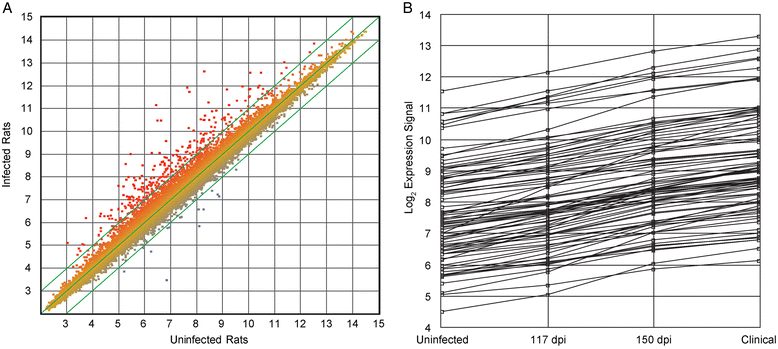Transcriptomic responses to prion disease in rats
- PMID: 26341492
- PMCID: PMC4560926
- DOI: 10.1186/s12864-015-1884-7
Transcriptomic responses to prion disease in rats
Abstract
Background: Prions diseases are fatal neurodegenerative diseases of mammals. While the molecular responses to prion infection have been extensively characterized in the laboratory mouse, little is known in other rodents. To explore these responses and make comparisons, we generated a prion disease in the laboratory rat by successive passage beginning with mouse RML prions.
Results: We describe the accumulation of rat prions, associated pathology and the transcriptional impact throughout the disease course. Comparative transcriptional profiling between laboratory mice and rats suggests that similar molecular and cellular processes are unfolding in response to prion infection. At the level of individual transcripts, however, variability exists between mice and rats and many genes deregulated by prion infection in mice are not affected in rats.
Conclusion: Our findings detail the molecular responses to prion disease in the rat and highlight the usefulness of comparative approaches to understanding neurodegeneration and prion diseases in particular.
Figures





Similar articles
-
Mouse-adapted sporadic human Creutzfeldt-Jakob disease prions propagate in cell culture.Int J Biochem Cell Biol. 2008;40(12):2793-801. doi: 10.1016/j.biocel.2008.05.024. Epub 2008 Jun 11. Int J Biochem Cell Biol. 2008. PMID: 18590830
-
[Mechanisms of neuroinvasion by prions: molecular principles and present state of research].Schweiz Med Wochenschr. 2000 Mar 25;130(12):435-42. Schweiz Med Wochenschr. 2000. PMID: 10780058 Review. German.
-
[Spongiform encephalitis].An R Acad Nac Med (Madr). 2001;118(3):633-52. An R Acad Nac Med (Madr). 2001. PMID: 11783043 Spanish.
-
Molecular clues to pathogenesis in prion diseases.Histol Histopathol. 1997 Apr;12(2):583-94. Histol Histopathol. 1997. PMID: 9151145 Review.
-
Molecular basis of cerebral neurodegeneration in prion diseases.FEBS J. 2007 Feb;274(3):606-11. doi: 10.1111/j.1742-4658.2007.05633.x. FEBS J. 2007. PMID: 17288549 Review.
Cited by
-
Mechanisms of prion-induced toxicity.Cell Tissue Res. 2023 Apr;392(1):81-96. doi: 10.1007/s00441-022-03683-0. Epub 2022 Sep 7. Cell Tissue Res. 2023. PMID: 36070155 Free PMC article. Review.
-
14-3-3 and enolase abundances in the CSF of Prion diseased rats.Prion. 2018;12(3-4):253-260. doi: 10.1080/19336896.2018.1513317. Epub 2018 Sep 12. Prion. 2018. PMID: 30149773 Free PMC article.
-
Neural transcriptomic signature of chronic wasting disease in white-tailed deer.BMC Genomics. 2022 Jan 21;23(1):69. doi: 10.1186/s12864-022-08306-0. BMC Genomics. 2022. PMID: 35062879 Free PMC article.
-
Age- and time-dependent mitochondrial genotoxic and myopathic effects of beta-guanidinopropionic acid, a creatine analog, on rodent skeletal muscles.Geroscience. 2023 Feb;45(1):555-567. doi: 10.1007/s11357-022-00667-4. Epub 2022 Sep 30. Geroscience. 2023. PMID: 36178599 Free PMC article.
-
Susceptibility of Beavers to Chronic Wasting Disease.Biology (Basel). 2022 Apr 26;11(5):667. doi: 10.3390/biology11050667. Biology (Basel). 2022. PMID: 35625395 Free PMC article.
References
-
- Booth S, Bowman C, Baumgartner R, Sorensen G, Robertson C, Coulthart M, et al. Identification of central nervous system genes involved in the host response to the scrapie agent during preclinical and clinical infection. J Gen Virol. 2004;85(Pt 11):3459–3471. doi: 10.1099/vir.0.80110-0. - DOI - PubMed
Publication types
MeSH terms
Substances
LinkOut - more resources
Full Text Sources
Other Literature Sources
Molecular Biology Databases

